Christoph Kern
Bias Begins with Data: The FairGround Corpus for Robust and Reproducible Research on Algorithmic Fairness
Oct 25, 2025Abstract:As machine learning (ML) systems are increasingly adopted in high-stakes decision-making domains, ensuring fairness in their outputs has become a central challenge. At the core of fair ML research are the datasets used to investigate bias and develop mitigation strategies. Yet, much of the existing work relies on a narrow selection of datasets--often arbitrarily chosen, inconsistently processed, and lacking in diversity--undermining the generalizability and reproducibility of results. To address these limitations, we present FairGround: a unified framework, data corpus, and Python package aimed at advancing reproducible research and critical data studies in fair ML classification. FairGround currently comprises 44 tabular datasets, each annotated with rich fairness-relevant metadata. Our accompanying Python package standardizes dataset loading, preprocessing, transformation, and splitting, streamlining experimental workflows. By providing a diverse and well-documented dataset corpus along with robust tooling, FairGround enables the development of fairer, more reliable, and more reproducible ML models. All resources are publicly available to support open and collaborative research.
Bias in the Loop: How Humans Evaluate AI-Generated Suggestions
Sep 10, 2025Abstract:Human-AI collaboration increasingly drives decision-making across industries, from medical diagnosis to content moderation. While AI systems promise efficiency gains by providing automated suggestions for human review, these workflows can trigger cognitive biases that degrade performance. We know little about the psychological factors that determine when these collaborations succeed or fail. We conducted a randomized experiment with 2,784 participants to examine how task design and individual characteristics shape human responses to AI-generated suggestions. Using a controlled annotation task, we manipulated three factors: AI suggestion quality in the first three instances, task burden through required corrections, and performance-based financial incentives. We collected demographics, attitudes toward AI, and behavioral data to assess four performance metrics: accuracy, correction activity, overcorrection, and undercorrection. Two patterns emerged that challenge conventional assumptions about human-AI collaboration. First, requiring corrections for flagged AI errors reduced engagement and increased the tendency to accept incorrect suggestions, demonstrating how cognitive shortcuts influence collaborative outcomes. Second, individual attitudes toward AI emerged as the strongest predictor of performance, surpassing demographic factors. Participants skeptical of AI detected errors more reliably and achieved higher accuracy, while those favorable toward automation exhibited dangerous overreliance on algorithmic suggestions. The findings reveal that successful human-AI collaboration depends not only on algorithmic performance but also on who reviews AI outputs and how review processes are structured. Effective human-AI collaborations require consideration of human psychology: selecting diverse evaluator samples, measuring attitudes, and designing workflows that counteract cognitive biases.
Defeating Prompt Injections by Design
Mar 24, 2025Abstract:Large Language Models (LLMs) are increasingly deployed in agentic systems that interact with an external environment. However, LLM agents are vulnerable to prompt injection attacks when handling untrusted data. In this paper we propose CaMeL, a robust defense that creates a protective system layer around the LLM, securing it even when underlying models may be susceptible to attacks. To operate, CaMeL explicitly extracts the control and data flows from the (trusted) query; therefore, the untrusted data retrieved by the LLM can never impact the program flow. To further improve security, CaMeL relies on a notion of a capability to prevent the exfiltration of private data over unauthorized data flows. We demonstrate effectiveness of CaMeL by solving $67\%$ of tasks with provable security in AgentDojo [NeurIPS 2024], a recent agentic security benchmark.
The Value of Prediction in Identifying the Worst-Off
Jan 31, 2025

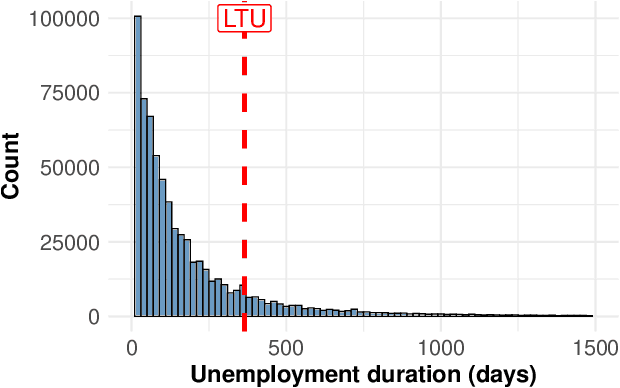

Abstract:Machine learning is increasingly used in government programs to identify and support the most vulnerable individuals, prioritizing assistance for those at greatest risk over optimizing aggregate outcomes. This paper examines the welfare impacts of prediction in equity-driven contexts, and how they compare to other policy levers, such as expanding bureaucratic capacity. Through mathematical models and a real-world case study on long-term unemployment amongst German residents, we develop a comprehensive understanding of the relative effectiveness of prediction in surfacing the worst-off. Our findings provide clear analytical frameworks and practical, data-driven tools that empower policymakers to make principled decisions when designing these systems.
Correcting Annotator Bias in Training Data: Population-Aligned Instance Replication (PAIR)
Jan 12, 2025Abstract:Models trained on crowdsourced labels may not reflect broader population views when annotator pools are not representative. Since collecting representative labels is challenging, we propose Population-Aligned Instance Replication (PAIR), a method to address this bias through statistical adjustment. Using a simulation study of hate speech and offensive language detection, we create two types of annotators with different labeling tendencies and generate datasets with varying proportions of the types. Models trained on unbalanced annotator pools show poor calibration compared to those trained on representative data. However, PAIR, which duplicates labels from underrepresented annotator groups to match population proportions, significantly reduces bias without requiring new data collection. These results suggest statistical techniques from survey research can help align model training with target populations even when representative annotator pools are unavailable. We conclude with three practical recommendations for improving training data quality.
The Missing Link: Allocation Performance in Causal Machine Learning
Jul 15, 2024Abstract:Automated decision-making (ADM) systems are being deployed across a diverse range of critical problem areas such as social welfare and healthcare. Recent work highlights the importance of causal ML models in ADM systems, but implementing them in complex social environments poses significant challenges. Research on how these challenges impact the performance in specific downstream decision-making tasks is limited. Addressing this gap, we make use of a comprehensive real-world dataset of jobseekers to illustrate how the performance of a single CATE model can vary significantly across different decision-making scenarios and highlight the differential influence of challenges such as distribution shifts on predictions and allocations.
Multi-CATE: Multi-Accurate Conditional Average Treatment Effect Estimation Robust to Unknown Covariate Shifts
May 28, 2024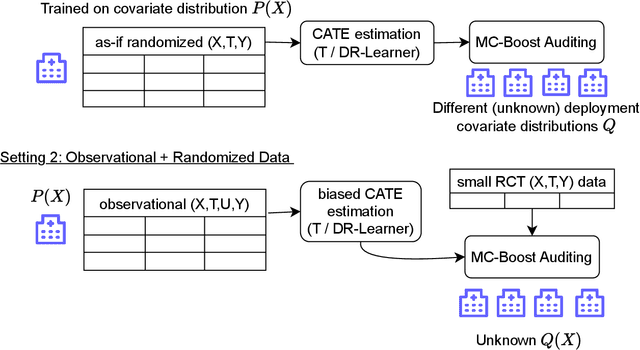
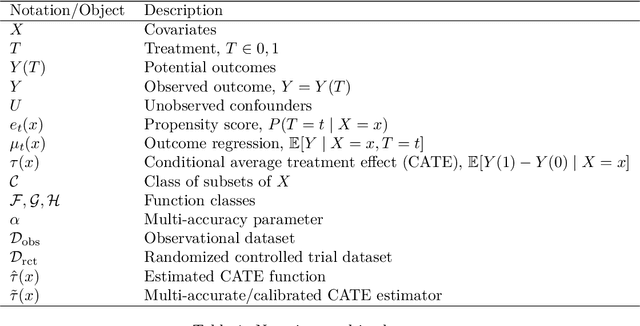
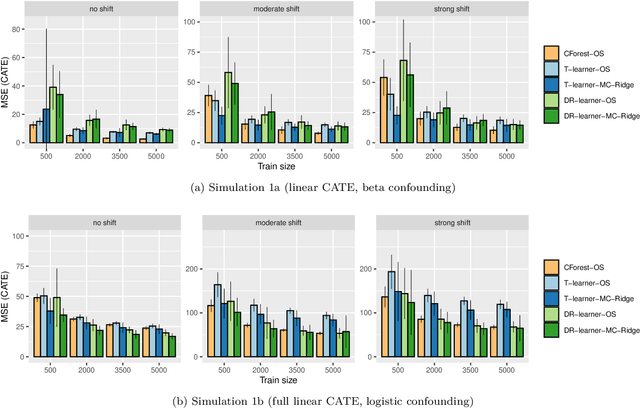
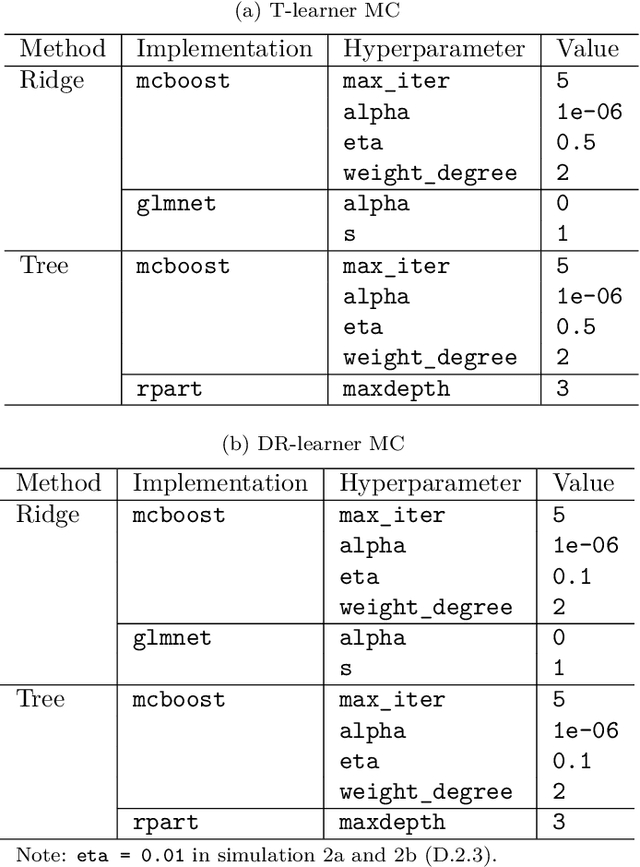
Abstract:Estimating heterogeneous treatment effects is important to tailor treatments to those individuals who would most likely benefit. However, conditional average treatment effect predictors may often be trained on one population but possibly deployed on different, possibly unknown populations. We use methodology for learning multi-accurate predictors to post-process CATE T-learners (differenced regressions) to become robust to unknown covariate shifts at the time of deployment. The method works in general for pseudo-outcome regression, such as the DR-learner. We show how this approach can combine (large) confounded observational and (smaller) randomized datasets by learning a confounded predictor from the observational dataset, and auditing for multi-accuracy on the randomized controlled trial. We show improvements in bias and mean squared error in simulations with increasingly larger covariate shift, and on a semi-synthetic case study of a parallel large observational study and smaller randomized controlled experiment. Overall, we establish a connection between methods developed for multi-distribution learning and achieve appealing desiderata (e.g. external validity) in causal inference and machine learning.
Lazy Data Practices Harm Fairness Research
Apr 26, 2024Abstract:Data practices shape research and practice on fairness in machine learning (fair ML). Critical data studies offer important reflections and critiques for the responsible advancement of the field by highlighting shortcomings and proposing recommendations for improvement. In this work, we present a comprehensive analysis of fair ML datasets, demonstrating how unreflective yet common practices hinder the reach and reliability of algorithmic fairness findings. We systematically study protected information encoded in tabular datasets and their usage in 280 experiments across 142 publications. Our analyses identify three main areas of concern: (1) a \textbf{lack of representation for certain protected attributes} in both data and evaluations; (2) the widespread \textbf{exclusion of minorities} during data preprocessing; and (3) \textbf{opaque data processing} threatening the generalization of fairness research. By conducting exemplary analyses on the utilization of prominent datasets, we demonstrate how unreflective data decisions disproportionately affect minority groups, fairness metrics, and resultant model comparisons. Additionally, we identify supplementary factors such as limitations in publicly available data, privacy considerations, and a general lack of awareness, which exacerbate these challenges. To address these issues, we propose a set of recommendations for data usage in fairness research centered on transparency and responsible inclusion. This study underscores the need for a critical reevaluation of data practices in fair ML and offers directions to improve both the sourcing and usage of datasets.
Connecting Algorithmic Fairness to Quality Dimensions in Machine Learning in Official Statistics and Survey Production
Feb 14, 2024Abstract:National Statistical Organizations (NSOs) increasingly draw on Machine Learning (ML) to improve the timeliness and cost-effectiveness of their products. When introducing ML solutions, NSOs must ensure that high standards with respect to robustness, reproducibility, and accuracy are upheld as codified, e.g., in the Quality Framework for Statistical Algorithms (QF4SA; Yung et al. 2022). At the same time, a growing body of research focuses on fairness as a pre-condition of a safe deployment of ML to prevent disparate social impacts in practice. However, fairness has not yet been explicitly discussed as a quality aspect in the context of the application of ML at NSOs. We employ Yung et al. (2022)'s QF4SA quality framework and present a mapping of its quality dimensions to algorithmic fairness. We thereby extend the QF4SA framework in several ways: we argue for fairness as its own quality dimension, we investigate the interaction of fairness with other dimensions, and we explicitly address data, both on its own and its interaction with applied methodology. In parallel with empirical illustrations, we show how our mapping can contribute to methodology in the domains of official statistics, algorithmic fairness, and trustworthy machine learning.
Annotation Sensitivity: Training Data Collection Methods Affect Model Performance
Nov 23, 2023
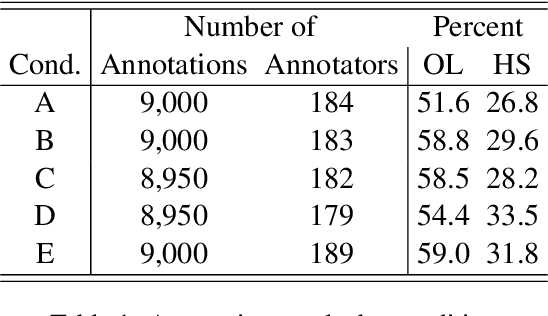
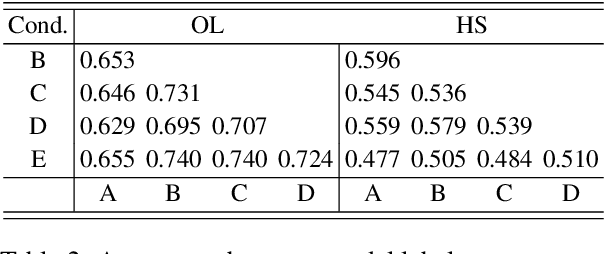
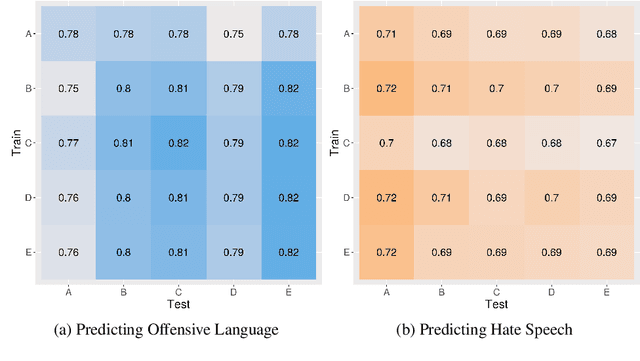
Abstract:When training data are collected from human annotators, the design of the annotation instrument, the instructions given to annotators, the characteristics of the annotators, and their interactions can impact training data. This study demonstrates that design choices made when creating an annotation instrument also impact the models trained on the resulting annotations. We introduce the term annotation sensitivity to refer to the impact of annotation data collection methods on the annotations themselves and on downstream model performance and predictions. We collect annotations of hate speech and offensive language in five experimental conditions of an annotation instrument, randomly assigning annotators to conditions. We then fine-tune BERT models on each of the five resulting datasets and evaluate model performance on a holdout portion of each condition. We find considerable differences between the conditions for 1) the share of hate speech/offensive language annotations, 2) model performance, 3) model predictions, and 4) model learning curves. Our results emphasize the crucial role played by the annotation instrument which has received little attention in the machine learning literature. We call for additional research into how and why the instrument impacts the annotations to inform the development of best practices in instrument design.
 Add to Chrome
Add to Chrome Add to Firefox
Add to Firefox Add to Edge
Add to Edge